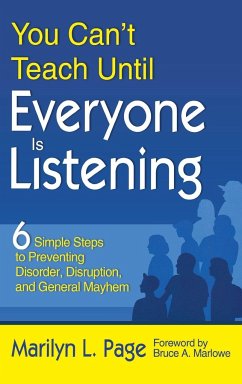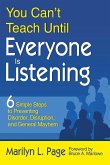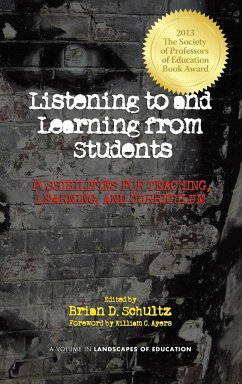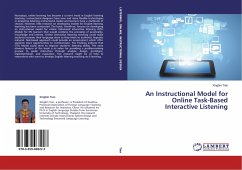Marilyn L. Page
You Can't Teach Until Everyone Is Listening
Six Simple Steps to Preventing Disorder, Disruption, and General Mayhem
Schade – dieser Artikel ist leider ausverkauft. Sobald wir wissen, ob und wann der Artikel wieder verfügbar ist, informieren wir Sie an dieser Stelle.
Marilyn L. Page
You Can't Teach Until Everyone Is Listening
Six Simple Steps to Preventing Disorder, Disruption, and General Mayhem
- Gebundenes Buch
- Merkliste
- Auf die Merkliste
- Bewerten Bewerten
- Teilen
- Produkt teilen
- Produkterinnerung
- Produkterinnerung
The author distills years of research and experience into six easy, proactive steps to establishing a classroom environment free of disruption and conducive to learning.
Andere Kunden interessierten sich auch für
![You Can't Teach Until Everyone Is Listening You Can't Teach Until Everyone Is Listening]() Marilyn L. PageYou Can't Teach Until Everyone Is Listening33,99 €
Marilyn L. PageYou Can't Teach Until Everyone Is Listening33,99 €![Listening to Children Read Listening to Children Read]() Alan PickardListening to Children Read10,99 €
Alan PickardListening to Children Read10,99 €![Implementing Strategy- based intruction to improve the Listening skill Implementing Strategy- based intruction to improve the Listening skill]() Mayra Silva OrtegaImplementing Strategy- based intruction to improve the Listening skill44,99 €
Mayra Silva OrtegaImplementing Strategy- based intruction to improve the Listening skill44,99 €![Listening to and Learning from Students Listening to and Learning from Students]() Listening to and Learning from Students106,99 €
Listening to and Learning from Students106,99 €![A Constructivist Approach to Listening in ELT A Constructivist Approach to Listening in ELT]() Pinar KahveciA Constructivist Approach to Listening in ELT27,99 €
Pinar KahveciA Constructivist Approach to Listening in ELT27,99 €![Giochiamo Tutti Insieme - 20 Games to Play with Children to Encourage and Reinforce Italian Language and Vocabulary Giochiamo Tutti Insieme - 20 Games to Play with Children to Encourage and Reinforce Italian Language and Vocabulary]() K. WilliamsGiochiamo Tutti Insieme - 20 Games to Play with Children to Encourage and Reinforce Italian Language and Vocabulary23,99 €
K. WilliamsGiochiamo Tutti Insieme - 20 Games to Play with Children to Encourage and Reinforce Italian Language and Vocabulary23,99 €![An Instructional Model for Online Task-Based Interactive Listening An Instructional Model for Online Task-Based Interactive Listening]() Xingbin TianAn Instructional Model for Online Task-Based Interactive Listening31,99 €
Xingbin TianAn Instructional Model for Online Task-Based Interactive Listening31,99 €-
-
-
The author distills years of research and experience into six easy, proactive steps to establishing a classroom environment free of disruption and conducive to learning.
Produktdetails
- Produktdetails
- Verlag: Corwin
- Seitenzahl: 168
- Erscheinungstermin: 8. Mai 2008
- Englisch
- Abmessung: 235mm x 157mm x 14mm
- Gewicht: 403g
- ISBN-13: 9781412960144
- ISBN-10: 1412960142
- Artikelnr.: 23336661
- Herstellerkennzeichnung
- Libri GmbH
- Europaallee 1
- 36244 Bad Hersfeld
- gpsr@libri.de
- Verlag: Corwin
- Seitenzahl: 168
- Erscheinungstermin: 8. Mai 2008
- Englisch
- Abmessung: 235mm x 157mm x 14mm
- Gewicht: 403g
- ISBN-13: 9781412960144
- ISBN-10: 1412960142
- Artikelnr.: 23336661
- Herstellerkennzeichnung
- Libri GmbH
- Europaallee 1
- 36244 Bad Hersfeld
- gpsr@libri.de
Marilyn Page is author (with Bruce Marlowe) of Creating and Sustaining the Constructivist Classroom (Corwin Press, 1998, 2005) and Creating the constructivist classroom, a six part video series for grades K-12 (The Video Journal of Education, 1999). She began her career in education as a high school social studies and Spanish teacher and has taught in every grade 7 through 12, at every academic level, in rural, suburban, and urban school systems in different parts of the United States. She has taught at the university level and worked with pre- and in-service teachers, grades K-12, for 20 years. She also directed a major and complex research project for the development of K-12 professional certification requirements in the State of Washington. In addition to full time university teaching responsibilities, she has been the technology coordinator for education programs at two universities and developed the first Middle School Teacher Preparation programs in the Vermont State College System. She earned her EdD from the University of Massachusetts in Amherst in Instructional Leadership and in Educational Media and Instructional Technology. She consults on novice teacher, reform, classroom management, and technology issues in education. She lives in State College, Pennsylvania.
Foreword by Bruce A. Marlowe Preface Acknowledgments About the Author Introduction 1. The Critical Beginning: Knowing and Using Students
Names Barry Knowing and Using Students
Names Your Number 1 Classroom Management Tool Student Teachers and Interns Novice and Experienced Elementary Teachers An Easy Strategy Other Approaches Back to Barry Summary: Step 1 What Comes Next? 2. Avoiding Anonymous and Dangling Questions Dave Types of Questions Teachers Ask Levels of Questions Teachers Ask Dangling Questions: What Are They and What Was Dave Doing Wrong? Students Left in the Dark Worse Consequences What Can You Do? The Problems With Hand Raising A Better Way An Old Teacher
s (or Is It Researcher
s) Tale The Results of These Better Strategies Anonymous Questions: What Are They? What
s Wrong With These Questions? How Can a Teacher Fix This? Did Dave Recover? The Experiment The Results Summary: Step 2 What
s Next? 3. Choosing and Using Words Wisely Mariah Mariah
s Goal What
s in a Word? The Importance of Tight and Professional Language What Are Filler Words? What Happens When You Use Filler Words? An Unprofessional Word Mariah
s Transformation Terry And Danae Using Words of Civility in the Classroom The Common Thread Three Other Powerful Hints About Language Making These Language and Tone Changes in Your Classroom Summary: Step 3 Coming Attractions 4. Avoiding Confusion When Giving Directions Elizabeth Clarifying Directions The Results A Pilot Project: A Different Story Chris What Are We Supposed to Do? Giving Instructions That Don
t Lead to Disruption Why It
s Important for Students to Re-explain Back Up! We Are Missing Two Preliminary Steps Chris
Plan The Results Summary: Step 4 What
s Next? 5. Attending to Civility With Reminders and Cues Seventh Period: A Special Ninth-Grade Class The First Day of School What Happened With This Class? Mrs. Watkins
Advice The Problem With Classroom Rules Simple Expectations of Civility Jeannie Reminders and Cues How Often Do You Have to Give Reminders or Cues? Jeannie
s Approach The Results The Bottom Line Summary: Step 5 Coming Next 6. Upgrading Interactions: Can You Feel the Heartbeat? The Title Julia Moving to a Higher Level Challenging Julia The Results Two Challenges for You How to Begin What Can Go Wrong Here? Subtle Classroom Disorder Jake Shy Students Detached Students National History Day Phil The Contest The Points of This Story The Results The Ultimate Goal Summary: Step 6 Now What? 7. Harry and Clara Reclaim Their Classes Harry Harry
s Mistake: An Ultimatum Harry
s Meltdown and Recovery The Letter The Students
Responses The Results Streamlining Harry
s Format Clara Claräs Approach The Results A Bonus: You Learn More Than You Think From Student Letters or Student Drawings Your Turn 8. Making This Happen Beginning Teacher Preparation Courses and Preservice Teachers University Professors Student Teachers Novice Teachers Experienced Teachers Bon Voyage Appendix: Handling Unwanted and Inappropriate Responses Examples References Index
Names Barry Knowing and Using Students
Names Your Number 1 Classroom Management Tool Student Teachers and Interns Novice and Experienced Elementary Teachers An Easy Strategy Other Approaches Back to Barry Summary: Step 1 What Comes Next? 2. Avoiding Anonymous and Dangling Questions Dave Types of Questions Teachers Ask Levels of Questions Teachers Ask Dangling Questions: What Are They and What Was Dave Doing Wrong? Students Left in the Dark Worse Consequences What Can You Do? The Problems With Hand Raising A Better Way An Old Teacher
s (or Is It Researcher
s) Tale The Results of These Better Strategies Anonymous Questions: What Are They? What
s Wrong With These Questions? How Can a Teacher Fix This? Did Dave Recover? The Experiment The Results Summary: Step 2 What
s Next? 3. Choosing and Using Words Wisely Mariah Mariah
s Goal What
s in a Word? The Importance of Tight and Professional Language What Are Filler Words? What Happens When You Use Filler Words? An Unprofessional Word Mariah
s Transformation Terry And Danae Using Words of Civility in the Classroom The Common Thread Three Other Powerful Hints About Language Making These Language and Tone Changes in Your Classroom Summary: Step 3 Coming Attractions 4. Avoiding Confusion When Giving Directions Elizabeth Clarifying Directions The Results A Pilot Project: A Different Story Chris What Are We Supposed to Do? Giving Instructions That Don
t Lead to Disruption Why It
s Important for Students to Re-explain Back Up! We Are Missing Two Preliminary Steps Chris
Plan The Results Summary: Step 4 What
s Next? 5. Attending to Civility With Reminders and Cues Seventh Period: A Special Ninth-Grade Class The First Day of School What Happened With This Class? Mrs. Watkins
Advice The Problem With Classroom Rules Simple Expectations of Civility Jeannie Reminders and Cues How Often Do You Have to Give Reminders or Cues? Jeannie
s Approach The Results The Bottom Line Summary: Step 5 Coming Next 6. Upgrading Interactions: Can You Feel the Heartbeat? The Title Julia Moving to a Higher Level Challenging Julia The Results Two Challenges for You How to Begin What Can Go Wrong Here? Subtle Classroom Disorder Jake Shy Students Detached Students National History Day Phil The Contest The Points of This Story The Results The Ultimate Goal Summary: Step 6 Now What? 7. Harry and Clara Reclaim Their Classes Harry Harry
s Mistake: An Ultimatum Harry
s Meltdown and Recovery The Letter The Students
Responses The Results Streamlining Harry
s Format Clara Claräs Approach The Results A Bonus: You Learn More Than You Think From Student Letters or Student Drawings Your Turn 8. Making This Happen Beginning Teacher Preparation Courses and Preservice Teachers University Professors Student Teachers Novice Teachers Experienced Teachers Bon Voyage Appendix: Handling Unwanted and Inappropriate Responses Examples References Index
Foreword by Bruce A. Marlowe Preface Acknowledgments About the Author Introduction 1. The Critical Beginning: Knowing and Using Students
Names Barry Knowing and Using Students
Names Your Number 1 Classroom Management Tool Student Teachers and Interns Novice and Experienced Elementary Teachers An Easy Strategy Other Approaches Back to Barry Summary: Step 1 What Comes Next? 2. Avoiding Anonymous and Dangling Questions Dave Types of Questions Teachers Ask Levels of Questions Teachers Ask Dangling Questions: What Are They and What Was Dave Doing Wrong? Students Left in the Dark Worse Consequences What Can You Do? The Problems With Hand Raising A Better Way An Old Teacher
s (or Is It Researcher
s) Tale The Results of These Better Strategies Anonymous Questions: What Are They? What
s Wrong With These Questions? How Can a Teacher Fix This? Did Dave Recover? The Experiment The Results Summary: Step 2 What
s Next? 3. Choosing and Using Words Wisely Mariah Mariah
s Goal What
s in a Word? The Importance of Tight and Professional Language What Are Filler Words? What Happens When You Use Filler Words? An Unprofessional Word Mariah
s Transformation Terry And Danae Using Words of Civility in the Classroom The Common Thread Three Other Powerful Hints About Language Making These Language and Tone Changes in Your Classroom Summary: Step 3 Coming Attractions 4. Avoiding Confusion When Giving Directions Elizabeth Clarifying Directions The Results A Pilot Project: A Different Story Chris What Are We Supposed to Do? Giving Instructions That Don
t Lead to Disruption Why It
s Important for Students to Re-explain Back Up! We Are Missing Two Preliminary Steps Chris
Plan The Results Summary: Step 4 What
s Next? 5. Attending to Civility With Reminders and Cues Seventh Period: A Special Ninth-Grade Class The First Day of School What Happened With This Class? Mrs. Watkins
Advice The Problem With Classroom Rules Simple Expectations of Civility Jeannie Reminders and Cues How Often Do You Have to Give Reminders or Cues? Jeannie
s Approach The Results The Bottom Line Summary: Step 5 Coming Next 6. Upgrading Interactions: Can You Feel the Heartbeat? The Title Julia Moving to a Higher Level Challenging Julia The Results Two Challenges for You How to Begin What Can Go Wrong Here? Subtle Classroom Disorder Jake Shy Students Detached Students National History Day Phil The Contest The Points of This Story The Results The Ultimate Goal Summary: Step 6 Now What? 7. Harry and Clara Reclaim Their Classes Harry Harry
s Mistake: An Ultimatum Harry
s Meltdown and Recovery The Letter The Students
Responses The Results Streamlining Harry
s Format Clara Claräs Approach The Results A Bonus: You Learn More Than You Think From Student Letters or Student Drawings Your Turn 8. Making This Happen Beginning Teacher Preparation Courses and Preservice Teachers University Professors Student Teachers Novice Teachers Experienced Teachers Bon Voyage Appendix: Handling Unwanted and Inappropriate Responses Examples References Index
Names Barry Knowing and Using Students
Names Your Number 1 Classroom Management Tool Student Teachers and Interns Novice and Experienced Elementary Teachers An Easy Strategy Other Approaches Back to Barry Summary: Step 1 What Comes Next? 2. Avoiding Anonymous and Dangling Questions Dave Types of Questions Teachers Ask Levels of Questions Teachers Ask Dangling Questions: What Are They and What Was Dave Doing Wrong? Students Left in the Dark Worse Consequences What Can You Do? The Problems With Hand Raising A Better Way An Old Teacher
s (or Is It Researcher
s) Tale The Results of These Better Strategies Anonymous Questions: What Are They? What
s Wrong With These Questions? How Can a Teacher Fix This? Did Dave Recover? The Experiment The Results Summary: Step 2 What
s Next? 3. Choosing and Using Words Wisely Mariah Mariah
s Goal What
s in a Word? The Importance of Tight and Professional Language What Are Filler Words? What Happens When You Use Filler Words? An Unprofessional Word Mariah
s Transformation Terry And Danae Using Words of Civility in the Classroom The Common Thread Three Other Powerful Hints About Language Making These Language and Tone Changes in Your Classroom Summary: Step 3 Coming Attractions 4. Avoiding Confusion When Giving Directions Elizabeth Clarifying Directions The Results A Pilot Project: A Different Story Chris What Are We Supposed to Do? Giving Instructions That Don
t Lead to Disruption Why It
s Important for Students to Re-explain Back Up! We Are Missing Two Preliminary Steps Chris
Plan The Results Summary: Step 4 What
s Next? 5. Attending to Civility With Reminders and Cues Seventh Period: A Special Ninth-Grade Class The First Day of School What Happened With This Class? Mrs. Watkins
Advice The Problem With Classroom Rules Simple Expectations of Civility Jeannie Reminders and Cues How Often Do You Have to Give Reminders or Cues? Jeannie
s Approach The Results The Bottom Line Summary: Step 5 Coming Next 6. Upgrading Interactions: Can You Feel the Heartbeat? The Title Julia Moving to a Higher Level Challenging Julia The Results Two Challenges for You How to Begin What Can Go Wrong Here? Subtle Classroom Disorder Jake Shy Students Detached Students National History Day Phil The Contest The Points of This Story The Results The Ultimate Goal Summary: Step 6 Now What? 7. Harry and Clara Reclaim Their Classes Harry Harry
s Mistake: An Ultimatum Harry
s Meltdown and Recovery The Letter The Students
Responses The Results Streamlining Harry
s Format Clara Claräs Approach The Results A Bonus: You Learn More Than You Think From Student Letters or Student Drawings Your Turn 8. Making This Happen Beginning Teacher Preparation Courses and Preservice Teachers University Professors Student Teachers Novice Teachers Experienced Teachers Bon Voyage Appendix: Handling Unwanted and Inappropriate Responses Examples References Index








